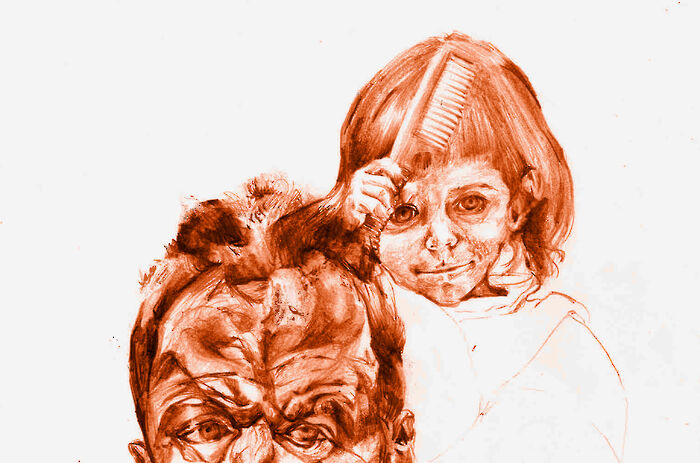How a VR Mona Lisa could make art more accessible
Esmee Wright rates the Louvre’s new virtual reality installation, which allows visitors to enter inside the museum’s most famous painting

To mark the 500th anniversary of the death of Leonardo da Vinci, the Louvre will be opening a new exhibition dedicated to his works. As part of this, of course, a great deal of focus will be placed on the Louvre’s pride and joy, the Mona Lisa. This makes sense, since her beauty was until recently confined to a different room while the Salle des États was being renovated. Visitors to her temporary boudoir complained of crowds, which meant they rarely got more than a glimpse of this surprisingly diminutive masterpiece. Unfortunately, given the painting is only 30 inches tall and indistinct by design, not to mention sullied by weathering and a daily draw estimated at around 30,000 people, the problem doesn’t abate when she is restored to her traditional resting place.
Visitors can overcome the distance between themselves and the 500-year-old painting
In order to enhance the experience of seeing the Mona Lisa, and combat the issue of crowds, the Louvre is putting on a virtual reality experience, Face to face with the Mona Lisa, in conjunction with the exhibition. To be held in a small gallery room by the main Leonardo exhibition, it will allow visitors to overcome entirely the distance between themselves and the 500-year-old painting. They will also be able to learn more about the painting itself, the process of its creation and conservation, and the identity of the sitter.

And yet, as always with these sorts of things, the plan has caused controversy. Some art critics, including Didier Rykner, founder of the art journal La Tribune de l’Art, have contested the French Ministry of Culture’s decision to spend so much money on virtual reality as an access point to works of art. In his essay, Rykner does make the reasonable point that certain museums and churches outside of Paris contain important works of art but remain closed due to staff and funding shortages, while the Ministry is throwing 3 million euros at the virtual reality project.
Yet I fundamentally disagree with the claim that the money should be spent on “buy[ing] three masterpieces that you could give to the museums in France”. The focus on the Mona Lisa is a relatively recent obsession, which often causes people to overlook the value of other pieces of art. However, it must be acknowledged that this painting, for better or worse, is one of the first stepping stones most people will take into the art world. They might not be able to tell a Caravaggio from a Klimt, or know what the golden ratio is, but children all across the world will know the Mona Lisa’s smile. And this matters so very much.

My hometown was not exactly affluent. In high school, I used to help out with youth trips to the Louvre, an eight-hour train journey away. These were children who might never have actually set foot inside even the free art museums in Edinburgh, only a 40-minute bus ride from them. There was always the hope that, in encountering the Mona Lisa in the flesh, a few might be inspired to take more of an interest in the arts. Unfortunately, staring at a small dark painting from a distance, with the heads of hundreds of other tourists in the way, never really inspired anyone – we knew the kids were only there for Disneyland. But what if these children had the opportunity to actually interact with the painting, to discover just why people make such a big fuss over it, and, moreover, to encounter all this information within a genuinely cool virtual reality set up? I think we might have had more success.
Virtual reality programmes like this could allow people with disabilities to interact with artworks
And it’s not just children who would benefit from the introduction of virtual reality displays. When the Musée de l’Orangerie opened a virtual reality experience based around Claude Monet’s Water Lilies cycle, people of all ages and abilities embraced the technology, discovering the gardens that inspired the paintings – this is simply not possible for many people to do in reality for whole swathes of reasons. Virtual reality programmes like this could allow people with disabilities to interact with artworks in a way that the often inaccessible traditional museum set up has so far prevented.
And so, with the greatest respect to Didier Rykner and those who see the technical skill of the Old Masters as irreconcilable with the technical innovations of the modern day, I am looking forward to this new exhibition. After all, it’s not like we weren’t already looking at the Mona Lisa exclusively through our phone screens anyway. What’s a little VR upgrade? Either we embrace the introduction of technology into the art world, and with it, the millions of people previously excluded by the multitudinous gates it has erected, or that world must admit that it simply doesn’t want to let everyone in.
 Music / The pipes are calling: the life of a Cambridge Organ Scholar25 April 2025
Music / The pipes are calling: the life of a Cambridge Organ Scholar25 April 2025 Arts / Plays and playing truant: Stephen Fry’s Cambridge25 April 2025
Arts / Plays and playing truant: Stephen Fry’s Cambridge25 April 2025 Comment / Cambridge builds up the housing crisis25 April 2025
Comment / Cambridge builds up the housing crisis25 April 2025 Interviews / Dr Ally Louks on going viral for all the wrong reasons25 April 2025
Interviews / Dr Ally Louks on going viral for all the wrong reasons25 April 2025 News / Candidates clash over Chancellorship25 April 2025
News / Candidates clash over Chancellorship25 April 2025






